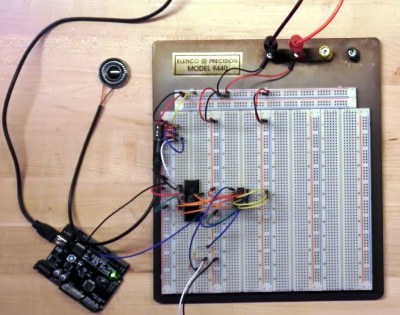Between 1976 and 1978, over one million Coleco Telstar video game consoles were sold. The Killer App that made them so desirable? PONG. Yep, those two paddles bouncing a ball around a blocky tennis court were all the rage and helped usher in a new era. And as [Dave] of Dave’s Garage shows us in the video below the break, the bringing the old console back to life proved simpler than expected!
Thankfully, the console is built around what [Dave] quite aptly calls “PONG on a chip”, the General Instrument AY-3-8500 which was designed to make mass production of consoles possible. The chip actually contains several games, although PONG was the only one in use on the Coleco.
 After removing the CPU from the non-functional console, [Dave] breathed life into it by providing a 2 MHz clock signal that was generated by an Arduino, of all things. A typical 2N2222 amplifies the audio, and a quick power up showed that the chip was working and generating audio.
After removing the CPU from the non-functional console, [Dave] breathed life into it by providing a 2 MHz clock signal that was generated by an Arduino, of all things. A typical 2N2222 amplifies the audio, and a quick power up showed that the chip was working and generating audio.
Video is smartly taken care of just as it was in the original design, by combining various signals with a 4072 OR gate. With various video elements and synchronization patterns combined into a composite video signal, [Dave] was able to see the game on screen, but then realized that he’d need to design some “paddles”. We’ll leave that up to you to watch in the video, but make sure to check the comments section for more information on the design.
Is a breadboarded PONG console not retro enough for you? Then check out this old school mechanical version that was found languishing in a thrift store.
















It’s not a CPU. Based on die photos, it’s more akin to a microcontroller (MCU), as it has not just a (serial) processor in it, but also the video and audio-generation circuitry. The OR gate is mainly just to combine horizontal sync, vertical sync, and luminance into one outgoing composite signal – the video signals themselves are generated on-board.
It’s not even a microcontroller. It is random logic based on a counter chain driving a bunch of flip-flops and gates. Different groups of logic were brought out as separate outputs so that the various display elements (paddle, ball, walls) could have different luma or chroma applied before the final mix to composite video.
Look for the book “How to Design & Build Your Own Custom TV Games” by David L. Heiserman, there’s a PDF out there. It’s over 500 pages, and starts with a clone of the Pong master counters, then builds experiments on top of it.
Pong wasn’t a killer app, it was the game available at the start. The novelty of an electronic game drove it. But after a bit, it was incredibly repetitious. People paid a lot of money, and soon they sat unused under the tv set.
It was only with time that other games became available.
Is the RC circuit possibly eliminating switch bounce? Do the paddles stutter without the caps connected?
If someone uses pure hardware or software-defined RC circuit to debounce they shouldn’t be embedded engineers at all. It’s 2022 FFS, debouncing should be done with Kalman filter, not with some didly dildo straight from the 1980s Atari.
Yeah but it is still pong. Maybe the didly dildo is part of the experience :)
Kalmann filter? so 2010…
Now you should have your ML model for AI debounce otherwise your product won’t cut it…
Machine learning for denouncing? Please, I put the signal into an adc then upload it to a cloud service to check
“the console is built around what [Dave] quite aptly calls “PONG on a chip”, the General Instrument AY-3-8500 which was designed to make mass production of consoles possible. The chip actually contains several games”
What was the other games and more importantly who coded those? I think there’s an interesting story about this (these) chip(s) to be written!
You had “Practice”, a demo mode. Rifle Game 1 and 2 which required a lightgun (supported by the chip!), Tennis, known to us as Pong, Soccer (or Football depending on your region), and Squash. Also, if you wired up the selector correctly you could get seventh game called “Handicap” where one of the players has three paddles.
I had one as a kid that had all the games enabled via a switch.
There’s a wikipedia article that names the other games and chip variants.
I’m not able to find it so don’t hesitae to share it!
Timely article! I was just looking at prices of the AY-3-8500-1 (NTSC) and thinking of whipping up a Pong game for my kids. With the datasheet you can design a console easily and I think I’m going to design my first PCB as a single-board Pong machine. I made a really janky one with an Arduino Uno years back but real hardware is real hardware. I’d LOVE to do a totally TTL version but that’s a bit away with my skillset.
I built one of these on homemade PCB sometime in the late 70’s or early 80’s. Basically, that chip made even the smallest electronics manufacturer a “games manufacturer”. It was something like the MOSTEK or TI calculator chips in the early-mid 70’s – a race to the bottom, which we still see today.
Same here. I found the video a couple of days ago and have the chip already ordered and mounted on my breadboard. One of my kids just now in a Pong craze, as I made ChatGPT program it for us.
Good times =)
FYI There is a very authentic Arduino AY-3-8500 pong emulator here http://www.searle.wales/
Nice, thanks for sharing!